Work packages are the backbone of project management. They’re the smallest pieces of the puzzle, breaking down a project into bite-sized, manageable chunks. Picture them as the nuts and bolts of the work breakdown structure (WBS), streamlining project schedules, budgets, and cost estimates.
By carving up the workload this way, project managers get a clearer view, making it easier to track progress and hit those all-important milestones.
These packages are handed out to team members, each carrying their weight in the overall project. This approach not only helps in spotting potential risks but also keeps the project on track. It’s like having a GPS for your project—guiding you toward success by enhancing planning, execution, and, ultimately, the project's outcome.
Introduction to work packages in project management
In project management, work packages are the building blocks that pave the way to project success. Imagine them as the stepping stones in the WBS. They detail the who, what, and when—giving clear direction to team members on their roles. This clarity is crucial for planning and executing projects with precision.

Work packages aren’t just about organization; they’re about control. They play a pivotal role in estimating costs, setting up schedules, and budgeting. These packages are the heartbeat of monitoring performance, using tools like earned value management to keep the project ticking along. By defining tasks and assigning responsibilities, they make tracking progress and hitting milestones a breeze.
Definition of work packages
Work packages are where the rubber meets the road in project management. They’re the smallest unit in the WBS, carving the project into manageable sections for easy tracking and cost estimation. Each package ties back to a specific deliverable and a deadline, keeping the project on course.
With well-defined work packages, everyone knows their part. This not only sharpens the project budget but also trims down risks. These packages are essential for tracking progress, ensuring every milestone is within reach, and managing the project’s overall health with earned value management.
Understanding the concept of work packages
Think of work packages as the blueprint for project success. They map out every step needed to hit your milestones, making project planning a walk in the park. For the team, they’re a roadmap—clear and straightforward—detailing what needs to be done and when.
These packages also form the backbone of earned value management. They help in nailing down accurate cost estimates and keeping a firm grip on the budget. It’s like having a magnifying glass on the project, helping to spot risks, track progress, and steer the project toward success.
How to create effective work packages in project management
Creating effective work packages in project management with Bonsai requires a structured approach to ensure tasks are manageable and projects are completed efficiently. Begin by clearly defining the scope of each work package, outlining the specific tasks, deliverables, and objectives. This clarity is essential for accurate cost estimation, which is a key part of budgeting.
Bonsai's project management tools include features like bottom-up estimating, allowing you to break down costs for each task and create a comprehensive budget that covers labor, materials, and overheads.

Establishing planning is another crucial element. Bonsai allows you to develop detailed timelines with start and end dates for each task, as well as dependencies. This ensures that all team members understand their responsibilities and deadlines, promoting smooth project execution.
The platform's planning tools help visualize the project timeline, making it easier to adjust and track progress.
Budgeting in Bonsai is made easier with features that enable real-time tracking of expenses against the budget. You can set cost rates for team members and monitor both billable and non-billable hours, ensuring the project remains within financial constraints.
The Total Utilization and Billable Utilization bars in the report are color-coded to indicate the level of capacity utilization.

Bonsai also offers budget alerts and profitability reports, assisting you in managing resources effectively and preventing cost overruns.
In conclusion, utilizing Bonsai for creating work packages involves a blend of precise scope definition, accurate cost estimation, detailed scheduling, and careful budgeting. These components, backed by Bonsai's powerful project management tools, boost productivity and ensure successful project outcomes.
The role of work packages in project management
Work packages are the unsung heroes of project management. They slice the project into manageable chunks, nestled within the WBS, making life easier for everyone involved. Project managers distribute tasks among the team, ensuring that the workload is evenly spread and timelines are clear.
But there’s more to these packages than meets the eye. They’re key to keeping tabs on performance. Through earned value management, they provide a crystal-clear picture of project status, risks, and budget alignment. In short, work packages are indispensable tools that keep the project on the right path from start to finish.

Breaking down complex projects
Complex projects need a solid plan, and that’s where work packages shine. They take the chaos of a massive project and break it down into manageable, bite-sized pieces. The WBS plays a starring role here, dividing the project into clear sections that are easier to handle.
Regular performance checks are crucial. They help spot risks before they become problems, and this is where earned value management earns its keep. By keeping an eye on progress, the team can stay on top of their game, ensuring that milestones are met and the project stays on course.
Facilitating better communication
Good communication is the lifeblood of any project. Work packages help by clearly defining roles and responsibilities, making sure everyone is on the same page. The WBS acts as a guide, outlining what needs to be done and by whom.
Earned value management tools are invaluable here, tracking project status, schedule, and budget. Regular updates and meetings are key to spotting risks early, allowing for quick action. This not only boosts communication but also drives the project towards success.
Enhancing project control
Controlling a project is all about planning and precision. Work packages, outlined within the WBS, are critical for maintaining this control. They assist in estimating costs and managing the budget, ensuring that the project stays on track.
Project managers rely on earned value management to measure performance against the schedule and budget. This keeps everyone informed about the project’s status and highlights potential risks. Regular communication with the team is essential, helping to hit milestones and steer the project toward a successful conclusion.
Importance of work packages in project management
Work packages are the backbone of project management. They form the lowest level of a work breakdown structure (WBS). Project managers use them for detailed project planning, cost estimation, and defining milestones. Without work packages, managing the project schedule and budget becomes a Herculean task.
Work packages clarify responsibilities for team members, boosting performance. They also facilitate earned value management (EVM), improve tracking of project status, and help identify risks early. In essence, work packages are vital for successful project management.
Improving project planning
Project planning is a never-ending task for project managers. It ensures project performance. This involves setting up the project schedule, defining milestones, and assigning work packages. A well-crafted WBS details each step, making management easier.
Accurate cost estimation and strict budget management are crucial to avoid financial overruns. The project team must be ready to handle risks efficiently. Timely status updates are key to project success. EVM can further enhance planning.
Enhancing resource allocation
Effective project management hinges on resource allocation. The WBS helps project managers identify and distribute work packages among team members. It’s indispensable for project planning, providing a clear view of the schedule and budget.
EVM is another useful tool. It gauges performance by comparing cost estimation and project status. It identifies risks early, measures milestones accurately, and ensures proper resource allocation, driving project success.

Facilitating risk management
Risk management is crucial in project management. Tools like WBS and EVM help track performance, adjust schedules, and manage budgets. This involves accurate cost estimation, frequent status updates, and clear communication about milestones.
Identifying risks and allocating work packages are essential for successful planning. The project team plays a key role in achieving goals while mitigating risks. Close monitoring of all aspects, from budgeting to scheduling, ensures optimal performance and project success.
Creating effective work packages
Work packages are the foundation of effective project management. They are integral to the WBS and determine task distribution among team members. Project managers use them to enhance performance and avoid risks.
Work packages aid in planning, serving as building blocks for the schedule, budget, and cost estimation. They play a crucial role in EVM, helping gauge status and progress towards milestones.
Defining clear objectives
Clear objectives are paramount in project management. They help create a workable schedule and reliable cost estimation. Project managers must convey status and milestones to team members. Without clear objectives, risks increase and performance suffers.
Objectives are crucial in designing the WBS, which breaks down the project into manageable work packages. Using EVM, managers can ensure progress aligns with the budget. This feeds into strategic planning.
Identifying required resources
Successful projects need various resources. The project team, including managers, oversees progress and ensures adherence to the schedule.
The WBS is another key resource. It breaks the project into smaller work packages, aiding in cost estimation and milestone identification. Tools like EVM track status, budget, and risks. Ensuring these resources are in place enhances planning.
Setting realistic deadlines
Realistic deadlines are essential for optimal performance. A comprehensive WBS divides the project into manageable work packages. EVM aids in tracking status and managing the budget.
Setting milestones is crucial for planning. Team members must communicate about risks and schedules to ensure timely completion. Accurate cost estimation is vital for setting realistic deadlines without compromising the budget.
Implementing work packages with project management tools
Work packages are the bread and butter of project management. They’re the nitty-gritty details that turn a big idea into actionable tasks. When you break down a project into these bite-sized pieces, it becomes easier to manage. Each work package in the work breakdown structure (WBS) represents a specific task assigned to team members. This helps in nailing down precise cost estimates and setting up a realistic project schedule.
But that’s just scratching the surface. Work packages are also key in managing project risks and boosting overall performance. They provide a clear snapshot of where the project stands, making it easier to track milestones and manage budgets. With tools like earned value management, you can keep everything on track and ensure your project hits its goals.
1. Bonsai
Implementing work packages with project management tools makes project execution smoother by breaking down complex tasks into smaller, manageable units. These tools help with clear task assignments, tracking progress, and allocating resources, ensuring that each work package is completed efficiently and on time.
By using project management tools, teams can improve collaboration, minimize bottlenecks, and keep a clear overview of the project's status.

Bonsai, a well-known project management tool, offers numerous benefits for managing work packages. It features a user-friendly interface that makes task creation and assignment straightforward. Bonsai's strong tracking capabilities allow for real-time progress monitoring, helping teams stay on track.
Furthermore, its integration with other tools ensures smooth data flow and communication. Bonsai also provides detailed reporting and analytics, allowing project managers to make informed decisions and optimize workflows. Overall, Bonsai boosts productivity and supports successful project delivery.
2. Microsoft Project
Microsoft Project is like the Swiss Army knife for project managers. It’s packed with features that help you break down your project into manageable work packages. This tool not only helps you set up a work breakdown structure but also lets you establish clear milestones, keeping everyone on the same page.
What’s great about Microsoft Project is how it streamlines risk management, cost estimation, and budget tracking. You can keep a close eye on your project’s status through earned value management, making it easier to spot inefficiencies and improve your planning. It’s a comprehensive approach that ensures your team stays on schedule and within budget, leading to a win-win for everyone involved.
3. Asana
Asana is a game-changer when it comes to implementing work packages. It simplifies the whole process, from creating a work breakdown structure to keeping project milestones and status updates organized. With Asana, your project schedule becomes a well-oiled machine, and every team member knows their role.
This tool isn’t just about keeping things tidy—it’s also a powerful ally in risk management. Asana helps you with cost estimation and budget maintenance, using techniques like earned value management to keep everything on track. It’s all about making project management seamless and efficient, ensuring your team can focus on what really matters.
4. Trello
Trello takes a hands-on approach to work packages. It’s all about visualizing your project’s progress through the work breakdown structure. With Trello, you can map out your project milestones and schedule in a way that’s easy to digest, helping you assess performance at a glance.
Budgeting and cost estimation are a breeze with Trello, especially when you factor in risks and earned value management. It’s a tool that promotes effective planning and resource allocation, keeping everyone in the loop with timely updates. Whether it’s tracking tasks or managing the overall project, Trello makes sure nothing slips through the cracks.
Common mistakes in work package creation and how to avoid them
One big misstep in creating work packages is a sloppy work breakdown structure. You’ve got to clearly define tasks and ensure they align with your milestones. Another common mistake is getting the project schedule or cost estimates wrong, which can throw your entire budget off course. And don’t forget about communication—failing to keep the team updated on the project status can lead to chaos.
Avoid these pitfalls with solid planning. Get everyone involved early on, use earned value management to track progress, and keep your team in the loop. This way, you’ll dodge the common errors that can derail a project.
Overlooking the importance of details
In project management, the devil is in the details. If you’re not paying close attention to key processes like the work breakdown structure or cost estimation, you’re setting yourself up for trouble. Project risks can skyrocket if you miss something crucial, leading to delays and budget overruns.
Neglecting these details can also confuse your team, leaving them unclear about project milestones and status. This can seriously hinder the effectiveness of your earned value management system. Bottom line: details matter. Overlooking them is a shortcut to project failure.
Ignoring the interdependencies of tasks
Overlooking how tasks depend on each other is another trap project managers fall into. If you don’t account for these interdependencies in your work breakdown structure, your project schedule and budget could quickly spiral out of control. It’s not just about the tasks themselves—it’s about how they connect.
Ignoring these connections can lead to overlaps or gaps in your work packages, which can increase risks and disrupt your project’s flow. To keep everything on track, your team needs to manage these interdependencies carefully, ensuring an accurate picture of the project’s status and smooth execution.
Underestimating the time and resources needed
Underestimating the time and resources required for a project is a recipe for disaster. Skimping on these aspects can throw your schedule off course and harm your overall performance. The work breakdown structure and cost estimation are key parts of planning, and neglecting them can lead to unnecessary risks.
Without a realistic budget and properly allocated work packages, your team could end up overworked and under-resourced. This can lead to missed milestones and complications with earned value management. The takeaway? Don’t underestimate what’s needed to get the job done right.
Conclusion: Maximizing the benefits of work packages in project management
To get the most out of work packages, you’ve got to focus on smart planning, solid collaboration, and continuous performance monitoring. Work packages should be tightly integrated into your work breakdown structure, giving you a clear project schedule, accurate cost estimates, and early risk identification. This approach ensures that you stay on top of your project’s status and milestones while keeping your budget in check.
Using earned value management further optimizes the process, giving you real-time insights into how efficiently your work packages are being executed. This keeps your team aligned and moving toward the project’s goals.







